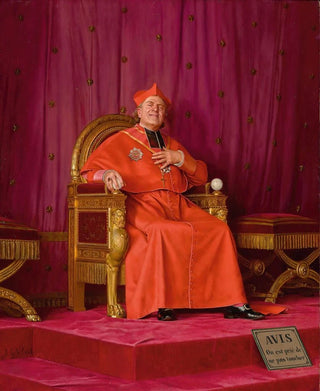Art print | If I Were King - Jehan Georges Vibert


View from behind

Frame (optional)
Art print Si J'étais Roi - Jehan Georges Vibert – Captivating Introduction
The artwork "Si J'étais Roi" by Jehan Georges Vibert transports the viewer into a universe where dream and reality intertwine with rare delicacy. This painting, emblematic of the late 19th century, evokes a time when imagination and playfulness took precedence over the strictness of everyday life. Vibert, with his keen eye for detail and mastery of color, invites us to contemplate a scene where role-playing and noble aspirations blend with a touch of humor. Through this piece, the artist captures the very essence of a world where children's innocence confronts adult ambitions, creating a visual narrative that fascinates and intrigues.
Style and uniqueness of the work
One of the most striking aspects of "Si J'étais Roi" lies in Vibert's distinctive style, which combines rigorous academic technique with a freer, more expressive approach. The characters, dressed in sumptuous costumes, are rendered with remarkable precision, while facial expressions reveal a palette of emotions ranging from mischief to daydreaming. The choice of colors, vibrant and luminous, emphasizes the joyful character of the scene, while the harmonious composition guides the viewer's eye through the artwork. Vibert does not merely depict a simple fable; he creates an immersive atmosphere where every detail contributes to the overall narrative. This ability to engage the audience in a reflection on human nature and desires makes "Si J'étais Roi" a timeless work, always relevant.
The artist and his influence
Jehan Georges Vibert, born in 1840, is an artist whose career is marked by a constant quest for artistic expression. Influenced by the masters of classical painting while aligning with the academic movement of his time, Vibert manages to stand out thanks to his unique sense of pictorial storytelling. His works, often populated with historical or mythological characters, testify to a fascination with stories and legends. By incorporating a playful and satirical dimension into his compositions, he invites the viewer to reflect on universal themes such as power

Matte finish

View from behind

Frame (optional)
Art print Si J'étais Roi - Jehan Georges Vibert – Captivating Introduction
The artwork "Si J'étais Roi" by Jehan Georges Vibert transports the viewer into a universe where dream and reality intertwine with rare delicacy. This painting, emblematic of the late 19th century, evokes a time when imagination and playfulness took precedence over the strictness of everyday life. Vibert, with his keen eye for detail and mastery of color, invites us to contemplate a scene where role-playing and noble aspirations blend with a touch of humor. Through this piece, the artist captures the very essence of a world where children's innocence confronts adult ambitions, creating a visual narrative that fascinates and intrigues.
Style and uniqueness of the work
One of the most striking aspects of "Si J'étais Roi" lies in Vibert's distinctive style, which combines rigorous academic technique with a freer, more expressive approach. The characters, dressed in sumptuous costumes, are rendered with remarkable precision, while facial expressions reveal a palette of emotions ranging from mischief to daydreaming. The choice of colors, vibrant and luminous, emphasizes the joyful character of the scene, while the harmonious composition guides the viewer's eye through the artwork. Vibert does not merely depict a simple fable; he creates an immersive atmosphere where every detail contributes to the overall narrative. This ability to engage the audience in a reflection on human nature and desires makes "Si J'étais Roi" a timeless work, always relevant.
The artist and his influence
Jehan Georges Vibert, born in 1840, is an artist whose career is marked by a constant quest for artistic expression. Influenced by the masters of classical painting while aligning with the academic movement of his time, Vibert manages to stand out thanks to his unique sense of pictorial storytelling. His works, often populated with historical or mythological characters, testify to a fascination with stories and legends. By incorporating a playful and satirical dimension into his compositions, he invites the viewer to reflect on universal themes such as power






